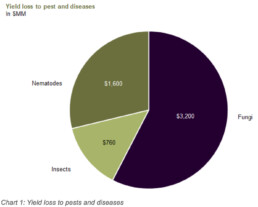InnerPlant Industry Report:
Pathogens in the United States
September 22, 2021
The InnerPlant industry report covers the impact of a variety of the most pervasive fungal diseases, nematodes, insects and a lot more. Our aim at InnerPlant is to inform farmers so they can do what they do best. We’ve constructed this report with research from leading industry experts and plant scientists after months of collaborating.
Main points from the InnerPlant pathogens report:
- Fungal diseases cost US farmers $3.2B each year in yield loss despite farmers spending $158M on fungicide chemicals.
- Asian Soybean Rust used to cost farmers $2B annually, but with a new dedicated pesticide, its damage is eliminated for a cost of $25 per acre.
- The best agronomic tools can only detect general stress after the damage is done.
InnerPlant pathogens report
Executive Summary:
Soybean farmers in the US lose approximately $5.5B annually in yields due to pests and disease damage in spite of spending $1.5B1 each year on fungicides, insecticides, and other treatments. The leading categories driving this loss are fungal diseases ($3.2B/yr), nematodes ($1.5B/yr), and insects ($2.4B/yr). This report will show that proper detection and timely target application could prevent losses up to $225M/yr for fungi, $330M/yr for nematodes, and $886M/yr for insects.
Key Takeaways:
Early and specific detection is the critical factor in maximizing the effectiveness of yield-saving mitigation measures with the potential to reclaim $1.4B of value for soybean farmers annually. However, existing tools are limited to detecting general stresses after significant damage has already occurred. A seed-based, plant-centric platform would provide specific detection of stresses weeks before existing methods and enable farmers to optimally apply mitigation measures that prevent yield loss while reducing costs from applying chemicals when less effective.
*1 At an average of $17 per acre 1
Our Findings:
Soybean farmers in the US lose approximately $5.5B annually in potential yield destroyed by pests and diseases (Chart 1). We studied dozens of reports by the USDA, APS Journals, farmer journals, University publications, and McKinsey. We then consulted with experienced farmers and agronomists to compile the following report which outlines the major pathogens, best practices for pathogen control, and the potential value that will be unlocked with early specific detection.

Section I – Fungal Diseases:
Fungal diseases affect soybean farmers in three ways:
- Yield reduction resulting from fungal crop damage
- Higher costs resulting from preventative or reactive fungicide applications
- Lower yield potential due to reduced planting density per acre
Fungal diseases in aggregate cost American farmers $3.2 billion annually in yield loss while spending $158 million annually on fungicide applications2. These dynamics represent an opportunity to increase yield through targeted and timely crop protection applications. For example, in Brazil, Asian Soybean Rust (ASR) historically created crop destruction resulting in $2B annual yield loss, since the introduction of a dedicated pesticide 2 decades ago, the damage to ASR has been eliminated at a cost averaging $25 an acre…